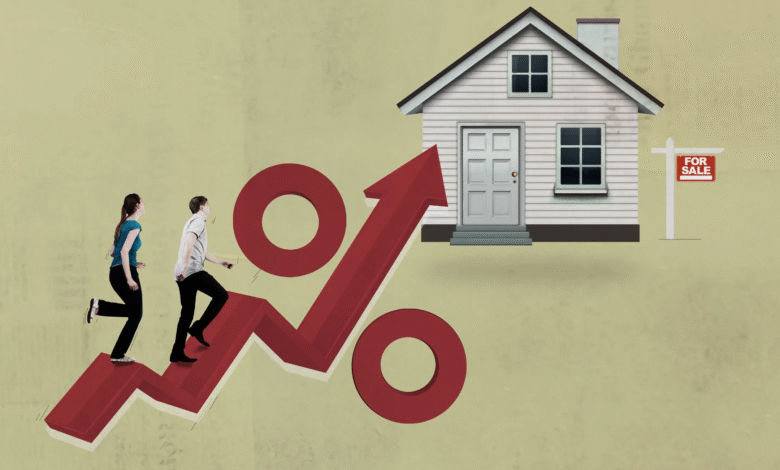Mortgage Demand Surges to Highest Level in Over a Month

Mortgage demand has surged to its highest level in over a month, indicating a renewed interest from homebuyers and those looking to refinance their current loans. As mortgage applications increase, the overall landscape suggests a promising uptick in the housing market. Current mortgage rates have remained relatively stable, with the average interest rate for 30-year fixed-rate mortgages now at 6.93%, slightly impacting refinancing trends. Notably, applications to refinance have jumped by 16%, showcasing a strong desire among homeowners to capitalize on favorable conditions. With ongoing shifts in housing market trends and a rise in available listings, many consumers are eager to navigate the opportunities presented by today’s mortgage offerings.
The recent spike in mortgage interest indicates a growing appetite for home financing solutions, particularly among potential buyers and those contemplating home loan refinancing. The uptick in interest reflects shifting dynamics in the property sector, where the demand for new home loans has risen significantly. As the data suggests, affordability challenges have nudged many to reconsider fixed-rate mortgages, especially at a time when average mortgage applications are climbing. Homeowners looking to optimize their investments are also seizing the moment as stable current mortgage rates offer a chance to secure favorable terms. This resurgence, buoyed by recent trends in housing inventory and borrowing costs, demonstrates the resilience of the home finance sector.
Mortgage Demand Surges After Holiday Adjustments
Recent reports indicate a significant surge in mortgage demand, reaching its highest level in over a month. The uptick in mortgage applications can be attributed to seasonal adjustments following the Memorial Day holiday, combined with a favorable housing market environment. This resurgence reflects a 12.5% increase in total mortgage application volume week-over-week, as reported by the Mortgage Bankers Association. Interestingly, this increase, while substantial on a weekly basis, remains historically low when viewed in a broader context.
Despite only a modest change in current mortgage rates, buyers are actively entering the market, reflecting confidence in home buying as significant supply levels emerge. Applications for home purchase mortgages rose by 10%, indicating a potential shift in buyer sentiment, driven by enhanced availability of listings. Real estate experts assert that this increase in supply—31% greater than the previous year—exacerbates the urgency for buyers to took for homes before prices stabilize or rise again.
Understanding Current Mortgage Rates and Their Impact
The average contract interest rate for 30-year fixed-rate mortgages has seen a slight increase lately, now standing at 6.93%. This minor adjustment has influenced home loan refinancing applications, which surged by 16% this past week alone. Investors and homebuyers alike remain watchful of the fluctuations in these rates, as they have a direct effect on their buying and refinancing decisions. Historical comparisons show that current rates are only slightly below the levels recorded a year ago, suggesting a stable but active market.
With the ongoing economic uncertainty, potential homebuyers are keenly aware of how current mortgage rates can influence their purchasing power. As rates have remained relatively stable, many are seizing the opportunity to refinance existing home loans. Lower monthly payments remain attractive to both new and existing homeowners, allowing them to benefit from the current lending landscape. Therefore, understanding these mortgage rates not only helps in making informed decisions but also in capitalizing on favorable market trends.
The State of the Housing Market: Trends and Outlook
The housing market currently exhibits signs of moderation, as home prices start to ease after a prolonged period of escalation. This trend is encouraging for potential buyers, particularly as applications for mortgages rise alongside an increase in available listings. According to Realtor.com, the current housing supply is approximately 31% higher than the same time last year, which indicates a shift towards a more balanced market. Expert analyses suggest that this shift could lead to enhanced affordability for buyers in the coming months.
In light of these changes, experts from the Mortgage Bankers Association note that the dynamics of supply and demand are beginning to favor buyers, particularly in certain markets. As the inventory of homes available for sale increases, buyers may have greater options and negotiating power, which could ultimately lead to higher success rates in securing home purchases. Observing these housing market trends is essential for prospective buyers and investors as they navigate their next steps in a complex economic environment.
The Role of Refinancing in Today’s Market
Refinancing has become a crucial aspect for many homeowners looking to optimize their mortgage conditions amid shifting rates. The recent 16% rise in refinancing applications indicates that borrowers are keen on capitalizing on the lower fixed-rate mortgages available. Homeowners are reconsidering their existing mortgage agreements to secure more favorable terms, reduce monthly payments, and potentially access home equity for other investments. Such trends signal an active and responsive refinancing market yearning for financial improvement amidst slight rate increases.
Home loan refinancing not only empowers existing borrowers but also provides a mechanism to stabilize monthly budgets, especially during uncertain economic times. As refinancing applications continue to rise, mortgage lenders are adapting their offerings to attract more clients and remain competitive. Overall, the refinancing landscape reflects the willingness of homeowners to reassess their financial commitments and the active role such decisions play in shaping the broader mortgage market.
Analyzing Consumer Sentiment in Mortgage Applications
Consumer sentiment plays a vital role in the mortgage application landscape, and current trends suggest a growing optimism among homebuyers and refinancers alike. Despite a backdrop of economic uncertainty, recent statistics show that mortgage applications for purchasing homes rose significantly, demonstrating a willingness to enter the market. This positive shift is likely driven by a mix of favorable mortgage rates and an increase in housing inventory, which collectively encourage buyers to make their move.
Furthermore, the upward trend in housing supply is reflected in the consumer mindset, as potential buyers feel more secure in exploring their home options without the pressure of scarcity. This growing confidence can lead to heightened activity in both purchasing and refinancing, ultimately influencing mortgage trends. Understanding consumer sentiment allows lenders and real estate professionals to tailor their strategies in a rapidly changing market.
Interest Rate Dynamics and Their Effect on Mortgage Demand
Interest rate dynamics are pivotal in shaping mortgage demand, with current trends indicating a careful watch by both buyers and lenders alike. The slight increase of 9 basis points in average contract rates for 30-year fixed mortgages encapsulates this phenomenon. As rates remain relatively stable after recent fluctuations, demand for new mortgages remains robust, particularly among those seeking to refinance existing properties. Buyers show keenness to lock in rates before any possible rises, highlighting the intertwined relationship between interest rates and mortgage applications.
Moreover, economic indicators such as inflation and trade discussions contribute to the volatility of mortgage rates and, consequently, demand. The expected upcoming inflation data release and ongoing negotiations with trade partners could impact bond markets, which directly correlate with how lending rates behave. Understanding these dynamics enables borrowers to make more strategic decisions regarding their mortgage applications, whether for new purchases or refinancing options.
Implications of Increased Home Listings on Mortgage Demand
The surge in available home listings, rising by 31% compared to last year, has significant implications for mortgage demand. More options in the housing market allow buyers to take swift action, as they are less constrained by limited inventory. This growing availability empowers potential homebuyers to explore different neighborhoods and property types, ultimately increasing the likelihood of securing financing through mortgage applications. The combination of greater choice and competitive pricing could attract a diverse pool of homebuyers.
As supply increases, buyers are presented with better opportunities to negotiate terms and reduce reliance on less favorable financing options. This shift is likely to bolster mortgage applications further, as buyers confidently pursue their purchasing goals. Consequently, an enhanced housing market atmosphere not only fuels demand but also fosters a healthier balance between buyers and sellers in negotiations, making it an advantageous environment for mortgage activity.
The Future of Mortgage Applications in a Shifting Economy
Looking ahead, the future of mortgage applications seems poised for evolution, shaped by both economic conditions and consumer behavior. With interest rates stabilizing and inventory levels increasing, potential homebuyers and those looking to refinance are likely to remain active in the market. Industry experts anticipate that as economic indicators provide clarity, mortgage demand could either surge or stabilize based on the overall financial sentiment of consumers. Understanding these factors will be essential for making informed lending decisions in this shifting landscape.
Furthermore, the interplay between rising home prices and mortgage availability will continue to create a dynamic environment for both buyers and lenders. As economic conditions fluctuate, keeping a close eye on projections for current mortgage rates and housing market trends will be vital. This awareness will help prospective buyers and investors confidently navigate the mortgage landscape, ensuring they can take advantage of optimal timing and rates when they arise.
Frequently Asked Questions
How does current mortgage demand affect mortgage applications?
Current mortgage demand significantly influences mortgage applications, as an increase in demand typically leads to higher application rates. Recently, applications for home loans rose, reflecting an uptick in interest from buyers looking to purchase homes or refinance existing mortgages due to favorable market conditions.
What are the current mortgage rates and their impact on mortgage demand?
Current mortgage rates stand at about 6.93% for 30-year fixed-rate mortgages, a factor that impacts mortgage demand directly. These rates can encourage or deter potential buyers and homeowners from applying for mortgages, influencing market trends in home buying and refinancing.
What trends are affecting mortgage demand in the housing market?
Recent trends indicate a rise in mortgage demand, driven by increased home listings and slight easing in home prices. The availability of more homes for sale has made home buying more appealing, thus boosting mortgage applications from those looking to secure new loans.
How do fixed-rate mortgages impact refinancing decisions in mortgage demand?
Fixed-rate mortgages, particularly at competitive rates, can incentivize homeowners to refinance their current loans. The recent rise in refinancing applications by 16% suggests that homeowners are looking to benefit from stable rates to lower their monthly payments or access equity.
What factors contribute to the fluctuations in mortgage demand?
Several factors contribute to fluctuations in mortgage demand, including current mortgage rates, economic conditions, and housing market trends. For example, adjustments in Treasury rates and economic indicators can create opportunities for borrowers, consequently affecting application volumes.
Why has mortgage demand increased recently following holiday adjustments?
Mortgage demand increased after holiday adjustments due to pent-up interest from homebuyers and lower supply constraints. Adjustments, such as the Memorial Day holiday, encouraged more potential buyers and refinancers to enter the market, further driving up mortgage application numbers.
How does home loan refinancing contribute to overall mortgage demand?
Home loan refinancing is a crucial component of overall mortgage demand, as many homeowners seek to take advantage of lower interest rates. With refinancing applications increasing by 16%, it indicates a strong preference among homeowners to move to more favorable mortgage terms, thus boosting overall market activity.
What should buyers consider when assessing current mortgage demand?
When assessing current mortgage demand, buyers should consider the stability of mortgage rates, available home listings, and economic indicators that could influence market conditions. Understanding these factors can help inform decisions on when to apply for a mortgage or refinance.
| Key Point | Statistic/Analysis |
|---|---|
| Average Contract Interest Rate for 30-year Fixed Mortgages | 6.93% (up from 6.92%) |
| Applications to Refinance | Increased by 16% this week; 28% higher than last year |
| Applications for Purchasing a Home | Rose by 10% this week; 20% higher than the previous week |
| Total Mortgage Application Volume Increase | 12.5% rise compared to the previous week |
| Home Supply Increase | 31% higher than last year |
| Current Economic Sentiment | Homebuyers taking advantage of additional listings despite economic uncertainty |
Summary
Mortgage demand has recently surged to its highest level in over a month following the Memorial Day holiday adjustments. This uptick in homebuyer interest, especially in refinancing options, indicates that borrowers are responding positively to the current housing market dynamics. With total mortgage applications rising significantly, it appears that potential homebuyers are seizing the opportunity amidst increasing inventory and stabilizing prices. Therefore, it’s clear that mortgage demand is being driven by a combination of favorable interest rates and a more available housing supply.




